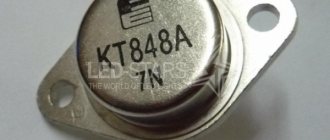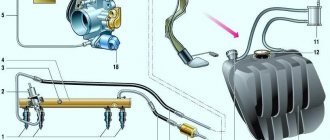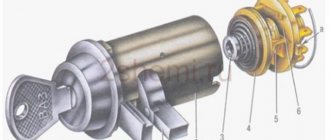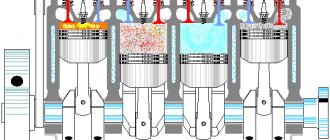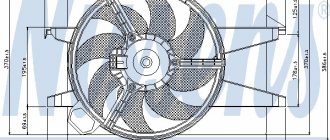Reading time: 6 minutes(s) Engine performance largely depends on the condition of such an element as the spark plugs. The spark that forms on its electrodes is responsible for igniting the air-fuel mixture in the combustion chamber.
However, over time, the structural elements of the spark plug wear out. This leads to the fact that a spark does not form on the electrodes or does not do so constantly. As a result, the mixture does not ignite, which is why the engine starts to stall and starts poorly. Accordingly, problems begin in the operation of the car - the power and dynamics of the power unit decrease, fuel consumption increases, and the wear of individual parts accelerates.
Spark plug
At the same time, we are not always talking about the need to replace spark plugs. It is likely that they are still working, but require maintenance. All that remains is to figure out how to check the spark plugs, which will allow you to determine whether they are serviceable or already require replacement.
When to check the condition of the spark plug - signs of faulty spark plugs
Worn and new spark plugs
Before you start checking the spark plugs, you need to make sure that the problems are in them and not in other components and blocks of the car. The following factors may indicate problems with these parts:
- There are problems starting the engine, especially when it is cold.
- Unstable operation of the power unit, which will clearly manifest itself at idle speed.
- Fuel consumption increases.
- A change in the color of the exhaust, it becomes bluish, which is associated with the entry of unignited fuel into the exhaust.
- The spark plug becomes wet, gasoline and oil remain on it, but this can only be determined by unscrewing it from the cylinder head.
The service life of classic spark plugs is up to 50 thousand km. However, in practice, their service life rarely exceeds 35 thousand km. Life expectancy largely depends on the quality of fuel and lubricants.
Iridium spark plugs can last up to 90 thousand km. But their cost is an order of magnitude higher, and it is necessary to calculate the feasibility of their use.
About selection
To ensure that the part does not accidentally collapse inside the motor, it is necessary to select the correct kits. For middle and low class cars, the following scheme is used. The simplest and inexpensive candles are purchased, but the manufacturer is known.
This is a valid approach. Although inexpensive spark plugs are designed for only 30 thousand kilometers, or even less, these sets are regularly replaced with new ones along with the replacement of filters and oils.
A new spark plug, even if it is simple, will work much better than an expensive product with a mileage of 60 thousand kilometers. Another argument in favor of installing new inexpensive parts is the quality of domestic fuel. Gasoline uses a huge number of different additives, which significantly reduce the life of the spark plug.
How to check spark plugs on a car without removing them
Checking the spark plug without removing it
There is a simple way to check spark plugs without removing them. To do this, just follow a few simple steps. In this case, no additional equipment is required. It is enough to start the engine and then perform the following operations:
- We disconnect the high-voltage wire (armored wire) from the first spark plug and listen to how the engine works.
- If the sound of operation changed, tripping or other problems appeared, then the spark plug was working.
- If nothing has changed, then such a spark plug is considered faulty by default.
We perform these actions one by one with all the candles. This is the easiest and most accessible way to check a car’s spark plugs, but it’s far from the only one.
What color is considered normal?
The performance of the gasoline power unit is indicated by spark plug electrodes painted in a light brown tint, without oil deposits and soot. A similar picture is observed in completely new engines and engines that have undergone a major overhaul.
If the color of the working part differs from the specified one, it is advisable to carry out further diagnostics and identify the cause of the problem. Moreover, the engine itself is not always the culprit. What color options are there for spark electrodes:
- light gray or white;
- black;
- brick or frankly red tint.
In addition to all sorts of colors, the candle skirt is covered with various deposits - soot, brown soot, or may simply look wet. These phenomena are also considered signs of various malfunctions. It is proposed to consider each situation in more detail.
How to check for spark on a spark plug
Checking for a spark at the spark plug
There is one easy option for checking removed spark plugs, which also does not require any equipment. It is enough to unscrew the spark plugs one by one, and then reconnect the high-voltage wires to them. In this case, with each of them we perform the following actions:
- We start the car.
- We bring the spark plug with the connected wire to the cylinder block.
- A noticeable bright spark should form between the spark plugs and the engine.
- If this does not happen, then the spark plug is most likely faulty.
In such cases, it is necessary to check the cleanliness of the spark plug and the gap. It may be enough to clean and adjust. If this does not help, then you will have to replace the spark plug.
Common mistake
To obtain a reliable result, the inspection must be carried out after the engine has been running for a long time. Otherwise, the inspection result will allow you to draw erroneous conclusions. Quite often there is a situation when drivers start a cold engine in winter and, hearing the sound of its uneven operation, turn off the spark plugs and turn them out.
Seeing black carbon deposits, they draw premature conclusions about the malfunction of the power unit, forgetting that black carbon deposits can form due to the fact that at subzero temperatures the working mixture is forcibly enriched, and due to the fact that the engine is not warmed up to the optimal temperature, it does not have time to burn completely . Unstable operation may well be explained by a malfunction of high-voltage wires that need to be replaced long ago.
How to check the condition of spark plugs by visual inspection
Spark Plug Inspection
Even a visual inspection can tell a lot about the condition of the spark plugs. Black, often long stripes on the insulator indicate a breakdown. Mechanical damage in any area will most likely lead to failure of the part.
Particular attention should be paid to the condition of the contacts. There should be no clearly noticeable soot of any color on them. If there is carbon deposits, then the spark plug may not produce a spark. In most cases, the color of the soot can determine the reason for its formation:
- Black soot mainly indicates poor quality of the fuel used. This may also indicate problems with valve stem seals or burnt out valves. In some cases, black carbon deposits are caused by an excessive amount of fuel supplied.
- Red, orange or brown spark plug contacts and carbon deposits indicate excessive use of additives. They are found in oil, and in some cases in low-quality fuel. Less commonly, this color can also indicate problems with the valves.
- The white color of the contacts with slight carbon deposits indicates insufficient fuel supply. If the carbon deposits are strong, similar to deposits in pipes and on old faucets, then the problem is most likely in the oil. The valve stem seals are worn out and the oil enters the combustion chamber, where it is burned.
Carbon deposits on the spark plug
Once you have checked the condition of the spark plug, you can decide whether to repair or replace it. If the carbon deposits are strong, then it is more advisable to replace it. If it is small, you can extend the life of the candle by cleaning, but this is a temporary solution.
Origin of red plaque
This phenomenon is less common than the effects described above. Why are there red electrodes on some spark plugs?
- the tank is filled with low quality gasoline with additives that increase the octane number;
- a car enthusiast or a fuel supplier adds additives to gasoline, which contain a large amount of metals;
- the owner of the car installed spark plugs in the cylinders that did not match the heat rating.
The reasons for the reddish tint of spark plugs do not pose a direct threat to the power unit, but are harmful in the long term.
Driving on low-quality gasoline with unknown additives a priori accelerates the wear of parts and components. Plus an increase in consumption arising from worsening combustion conditions of the mixture in the cylinders. Operating a car with spark plugs that are “cooler” or “hotter” in terms of heat rating reduces engine power and significantly shortens the life of the elements. A characteristic sign of incorrectly selected spark plugs is a drop in crankshaft speed at idle and missed ignition cycles.
How to check spark plugs with a multimeter
Checking the spark plug with a multimeter
A great way to check spark plugs at home is to use a multimeter. Usually every car owner has one; in extreme cases, you can lend it to your neighbor in your apartment or garage.
The easiest way to check the serviceability of a spark plug is to find out the resistance. To do this, you need to unscrew the spark plug and set the tester to measure resistance with an indicator of 20 kOhm. Next we perform the following operations:
- We connect one contact of the multimeter to the central electrode.
- The second one is for the contact nut.
- Normal resistance values for most internal combustion engines should be in the range from 5 to 15 kOhm.
- If the tester shows resistance between the electrode and the housing, then the spark plug is most likely not working.
- A multimeter can also detect spark plugs with zero resistance. But they are used in a strictly limited number of engines.
Checking the central electrode
It is important that you can check the spark plug for functionality with a multimeter only using the central electrode. There is a resistor on it that prevents the formation of an arc. It is he who creates resistance.
How to check spark plug gap
Checking the spark plug gap
An important parameter is the spark plug gap. The problem is that over time the contacts wear out and become thinner. Accordingly, the distance between the central electrode and the side electrodes increases. If it becomes excessively large, a spark will not form.
Before checking the gap on the spark plugs, you will need to prepare a special feeler gauge. In essence, it is a thin metal plate of a certain thickness. The kit usually contains several standard sizes, which allows for testing. It is enough to know what the parameter for the spark plugs of your engine should be and compare it with what is available in reality.
If the distance between the electrodes turns out to be very large, they can be bent to the desired value. This should be done carefully to avoid mechanical damage. However, this is a temporary solution and such spark plugs should be replaced as soon as possible.
The principle of operation of components of this type
Today, there are several types of components of this type that are installed in cars. Here we are talking about both photos of parts and the operation of spark plugs. So, here are the components:
- Spark type.
- Arc type.
- Catalytic type.
- Incandescent.
A person who has virtually no knowledge of this issue most often thinks about the issue of identifying spark plugs. First of all, it should be noted that in cars with a gasoline engine, the first types of spark plugs are used. In this case, the mixture is ignited by means of an electric discharge, which occurs using an electrode. The discharge voltage process can be measured in Volts. The indicator can be up to several thousand volts. The functioning of components is a streamlined process, since they begin to function the moment the car engine starts running.
A fairly large number of car owners mistakenly assume that if the engine diagnostic photo shows the spark plugs are in decent condition, then most likely there are no difficulties in the functioning of the engine. Even in the cold season, they will not need to be changed. Moreover, this statement is true only if the technical condition of the parts (candles) is good. To understand the condition of the component, you need to determine what the spark plug should look like. If you have this knowledge, then by looking at the appearance of the spark plugs, you will be able to determine exactly what condition they are in.
Checking with a gun
Checking the spark plug with a gun
There is a special device for checking spark plugs, which looks like a pistol. The principle of testing is quite simple - pressure is created, after which voltage is applied to the spark plug. If the light on the gun lights up, then it is working.
To check the serviceability of the spark plug using the device, perform the following steps:
- Insert a spark plug into a specially prepared socket.
- We put a cap on its other edge.
- We press the trigger and look at the indicator light.
However, this method remains not entirely correct, since, in fact, only the presence of a spark is determined. At the same time, the spark may be weak or form not on the electrodes, but on the body. So it’s better to check it in parallel using the methods described above.
Bottom line
There are many ways to check spark plugs. Some of them do not even require removing the spark plug or additional devices. This allows you to easily check spark plugs at home. In other cases, you will need a multimeter or a gun, removing the spark plug. The most correct way would be to check the candle on a stand, but you will have to pay for it. In some cases, the cost of the service is more than a new candle, which makes the operation with the stand pointless.
Read more useful information and interesting facts at!


